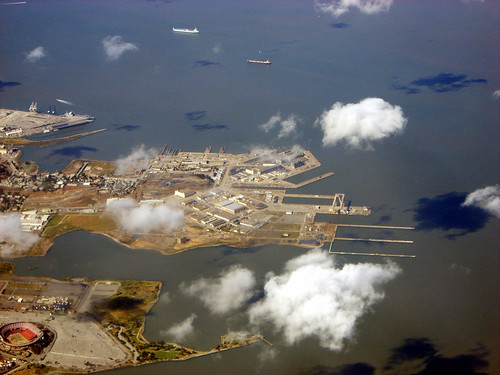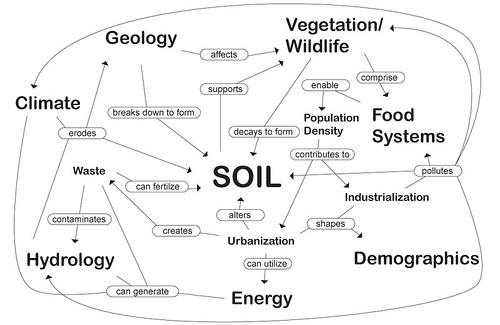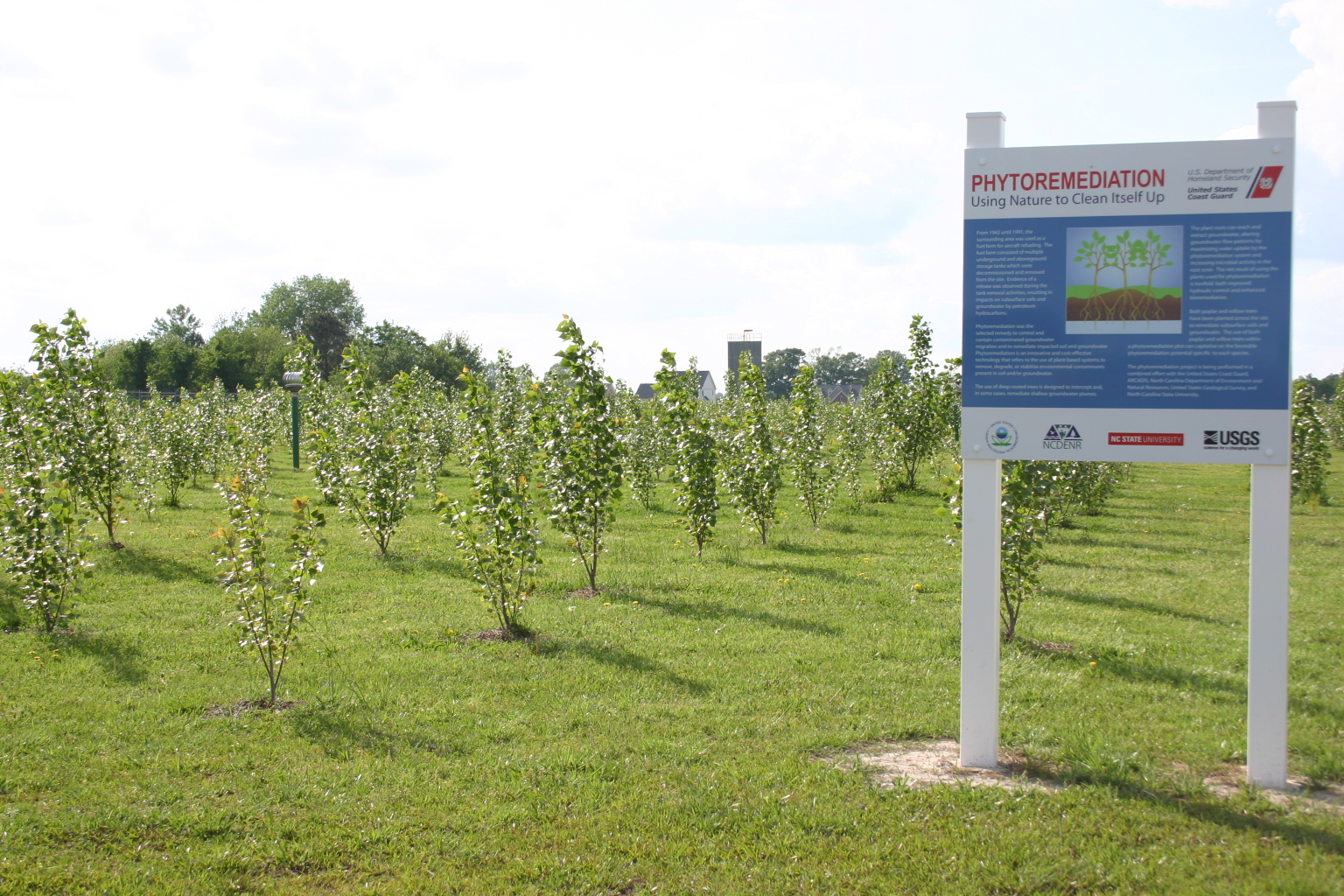 Hunters Point Shipyard is an unusually shaped peninsula hanging off the southeastern corner of San Francisco. Once an important Navy yard servicing the United States' Pacific fleet, Hunters Point today is 495 acres of artificial fill steeped in spilled diesel fuel, chemical solvents and radioactive heavy metals. A federal Superfund site, Hunters Point is eventually slated for construction as a mixed use development. The Navy is currently remediating the site by removing contaminated soil at great expense.
Hunters Point Shipyard is an unusually shaped peninsula hanging off the southeastern corner of San Francisco. Once an important Navy yard servicing the United States' Pacific fleet, Hunters Point today is 495 acres of artificial fill steeped in spilled diesel fuel, chemical solvents and radioactive heavy metals. A federal Superfund site, Hunters Point is eventually slated for construction as a mixed use development. The Navy is currently remediating the site by removing contaminated soil at great expense.The plan for Hunters Point calls for traditional remediation and an eventual cover of paving to keep soils away from human habitation. The reactivation of natural soil systems, though, could reduce dependency on infrastructure and provide a more complete long term clean-up solution. Furthermore, emerging technologies are generating novel bioremediation methods that change how contaminated sites can be cleaned. A closer look at soils and remediation is warranted.
 In natural ecological systems, soil is created as wind and water erode rock into ever smaller pieces. Simultaneously, plants convert carbon dioxide, water, and light into food, which moves through the food chain until it eventually decays into the soil as well. Over time, soil develops hydrological and biological cycles that support and reinforce each other, stabilizing the environment through meteorological and seasonal variations.
In natural ecological systems, soil is created as wind and water erode rock into ever smaller pieces. Simultaneously, plants convert carbon dioxide, water, and light into food, which moves through the food chain until it eventually decays into the soil as well. Over time, soil develops hydrological and biological cycles that support and reinforce each other, stabilizing the environment through meteorological and seasonal variations.
In urban soil systems, impervious paving and storm sewers disrupt the relationship between water and soil. Creeks are channeled into culverts, surface vegetation dies, and soils wash away in storms. By disrupting interdependent functions cycles, urbanization destabilizes beneficial soil systems.

For many cities coping with climate change and the environmental shifts that come with it, the reactivation of natural soils systems offers a means of reducing strain on sewer and drainage systems and adapting to more volatile weather. Functioning soil systems can act as ecological sponges, buffering the urban environment from extremes of flood and drought.
Yet like sponges, soils absorb more than just water. Broad varieties of industrial contaminants can be found in urban soils, and their presence has serious impacts on ecological functions. In places where this is the case, like Hunters Point, remediation is required before ecological systems can be reactivated.

Bioremediation, the use of living organisms to clean up industrial waste, is often the most efficient means of remediating contaminated sites. It can also seem like science fiction at times. In Chernobyl, hydroponic sunflowers were used to absorb radioactive heavy metals from lakes. Earlier this year, oil-soaked mats of human hair were digested by oyster mushrooms to clean an oil spill in San Francisco Bay. You can't make this stuff up!
 Usually, microbial bioremediation (using bacteria) and mycoremediation (using fungi) decomposes contaminants into other components, while phytoremediation (using plants) simply accumulates contaminants in their tissues for easier clearing. Scientists, however, are genetically engineering plants by splicing useful genes from other sources into hyperaccumulating species of mustard, poplar and willow.
Usually, microbial bioremediation (using bacteria) and mycoremediation (using fungi) decomposes contaminants into other components, while phytoremediation (using plants) simply accumulates contaminants in their tissues for easier clearing. Scientists, however, are genetically engineering plants by splicing useful genes from other sources into hyperaccumulating species of mustard, poplar and willow.In Indiana, for example, scientists have inserted a gene into poplar trees that breaks down trichloroethylene (TCE), an industrial solvent and common groundwater contaminant. The genetic modification allows Poplars to digest TCE where they once could only accumulate it, dramatically altering the role of phytoremediation. This sort of advance is incredible, but I wonder: can we go further?
 Genes for the production of bioluminescent proteins have been spliced into the DNA of cats, tobacco, and rabbits. Perhaps these genes for luminescence could be paired with genes that create enzymes that sequester or degrade harmful contaminants? Hunters Point could be planted with fields of willow and sunflower that glow in the night as they accumulate dangerous pollutants. High rates of remediation would be accompanied by brighter glowing; as the glow faded over months and years, it would signal that a given area is safe for habitation. The soil, remediated and reactivated, would be ready to support human use.
Genes for the production of bioluminescent proteins have been spliced into the DNA of cats, tobacco, and rabbits. Perhaps these genes for luminescence could be paired with genes that create enzymes that sequester or degrade harmful contaminants? Hunters Point could be planted with fields of willow and sunflower that glow in the night as they accumulate dangerous pollutants. High rates of remediation would be accompanied by brighter glowing; as the glow faded over months and years, it would signal that a given area is safe for habitation. The soil, remediated and reactivated, would be ready to support human use.Hunters Point will probably never be home to a forest of phytoremediating bioluminescent transgenic trees, but there is plenty of room for innovation at the polluted site. At Hunters Point and other contaminated sites around the world, restoring soil systems is becoming more realistic as scientists develop more incredible technologies and designers and planners find ways to apply them.
(Images Sources:
Hunters Point Aerial: Telstar Logistics
Soil Systems Illustrations: Jonathan Espalin
Soil Network: Josh S Jackson
Chernobyl Sunflowers: Phytoremediation History
Phytoremediation: Ideonexus
Transgenic Organisms: Biotechnologies Blog)

1 comment:
Great post! It's encouraging to hear that Hunter's Point is in the process of remediation. I used to live in Bayview and bike down 3rd Street to get to work. There was a two-block stretch through which it was really hard to breath because of an incredibly strong chemical odor. I wonder what that was from?
Post a Comment